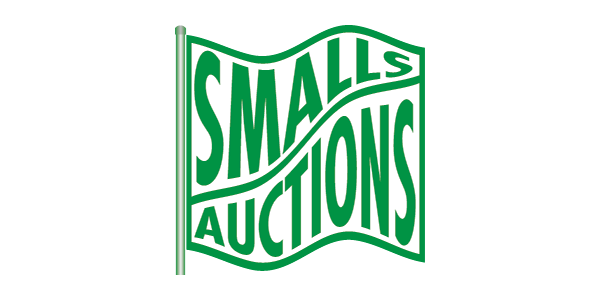Auction 98 Highlights
Welcome to Smalls Auctions Sale 98.
Collectors of Australia’s coins and banknotes will no doubt be aware of Australia’s adoption of
Decimal Currency on the 14 th February 1966. The old Imperial system of currency which it had
inherited from Britain with 12 pennies to the shilling and 20 shillings to the pound was replaced with
a monetary system whose units were either a fraction or multiple of the number 10. Be it ‘evolution’
or ‘intelligent design’ that arrived at 10 digits for the human race it certainly made things far easier
for the less numerate.
The change was not without its controversy with the Australian Prime Minister of the day plugging
for the ‘Royal’ as the unit of Australia’s new currency before ‘Cents’ prevailed and the ‘Dollar’
became the new Currency.
Australia’s old currency had been produced at numerous branches of the Royal Mint but in the
decades prior to the changeover to Decimal Currency it was largely being struck at the Melbourne
and Perth Mints. However, with a new currency came the new Royal Australian Mint in Canberra
which would be responsible for producing all of Australia’s coins. However, in the period of
transition to decimal currency the Melbourne Mint, the Perth Mint and the London Mint all played a
hand in producing coins for the changeover.
In our current sale we are concentrating on coins and banknotes specifically from Australia’s Decimal era including one of the most intriguing of the new coins from 1966.
This coin was first noticed in 1990 by a collector who found in his collection a strange Australian
1966 Proof 20 Cent like no other and, perhaps suspecting that he had been sold a ‘dud’, sent it off to
the Royal Australian Mint (RAM) Canberra for their ‘expert’ opinion.
After carefully examining the coin, the Mint declared it a genuine Proof 20 Cent coin but, not the
typical ‘Canberra’ struck proof of which 18,110 were made to be included in the inaugural 1966
Australian Decimal Proof sets, but a ‘London’ struck proof which matched the sole example the Mint
held in its collection. Mr R Gardiner, the Quality Manager at the RAM, wrote that “the coin you have
submitted has been examined in the Mint laboratories (and) matches the characteristics of a
genuine 20 cent Australian coin with the exception of mass which is below specification. However,
the mass is similar to that of a 1966 Proof London 20 cent which is held in the Mint museum.”
This weight difference can also be observed in the circulating ‘Canberra’ and ‘London’ 20 cent coins.
However, if the RAM had examined the coin more closely it would have discovered other marked
differences. Following tradition, the RAM, as the lead mint in producing Australia’s 1966 coinage did
not feel it necessary to distinguish its production with a mint mark, and so it was left to the Royal
Mint (RM) in the unusual role as a sub-contractor to employ a deliberate ‘marker’ to separate its
production from Canberra’s. If you look closely the ‘London’ struck coin is typified by having only
‘one’ eyelash on the Queen’s effigy whereas the ‘Canberra’ coin has two. As well, the effigy on the
RM Proof when measured from the tip of the Crown to the truncation is smaller (24mm) than on the
RAM Proof (25mm) and so sits further from the perimeter of the coin.
Interestingly, the ‘Machin’ portrait of Queen Elizabeth II first used on the corresponding British 10
‘new pence’ coins of 1971 also measures 24mm and also has ‘one’ eyelash (albeit lightly-struck)suggesting that the RM called on the same master obverse die that it used 5 years earlier on the Australian coin. And, even to the naked eye the RAM Proof 20c has heavy frosting on the raised
designs against a ‘mirrored blank’, whereas the RM Proof has no significant two-tone effect with
only minimal frosting of the highlights on a ‘polished blank’, very reminiscent of coins in British Proof sets of the era.
How this ‘London’ Proof 20 Cent coin made it into private hands is not known but, as it is usually
best practice for museum collections to hold at least two specimens of a coin so that the obverse
and reverse can be simultaneously displayed, the admission that “a similar coin is held by the Mint” may hint at its source. It has been speculated that perhaps the coin made its way out of the RAM collection when it was ‘gifted’ to the notorious coin forger David Allan Gee who had unfettered access to the Royal Australian Mint Collection in the 1970s. Gee financed his collecting interests by running a string of blue movie houses which were known to have been frequented by many influential people. This may explain his Svengali-like hold over James Henderson, the Controller of the Royal Australian Mint, who although aware of Gee’s unsavoury sideline still considered him a close confidant. Henderson was known to have ‘gifted’ important coins and banknotes to Gee from the RAM collection in recognition of professional advice he supposedly provided, and the 1966 ‘London’ polished Proof 20c coin could well be one such coin.
What is certain is the Royal Australian Mint laid no claim to the coin in 1990 when it was sent in for
verification, and so this ‘museum’ piece remains in the public domain and is the highlight of our
current sale.
Smalls Auctions

Australia. 1966 'London' Polished Proof 20c, PCGS PR63 CAM
Find Out More
Australia. 'Coombs - Randall' XBQ - First Prefix $20 (1968), good Very Fine
Find Out More
Australia. 'Stevens - Henry' First Prefix AA08 - 000000 $50 (2008), Uncirculated
Find Out More

